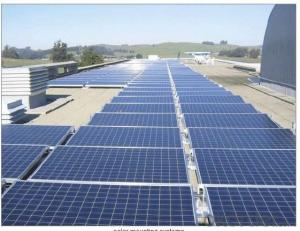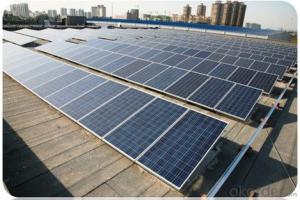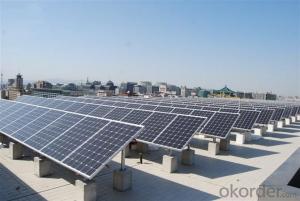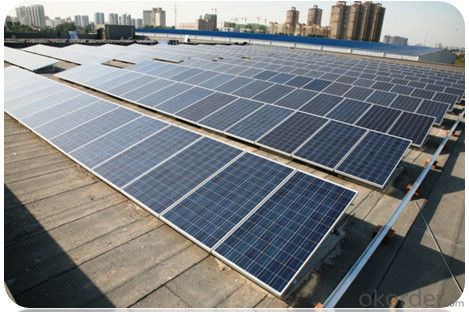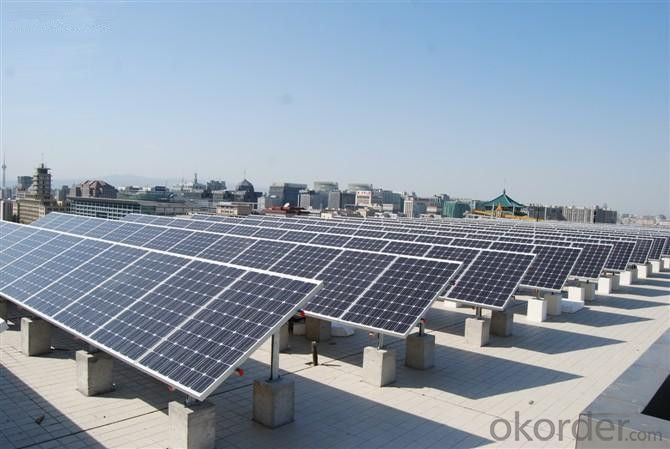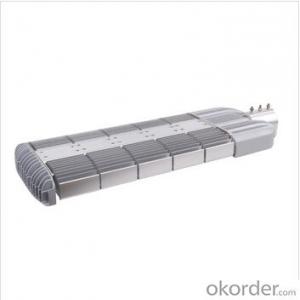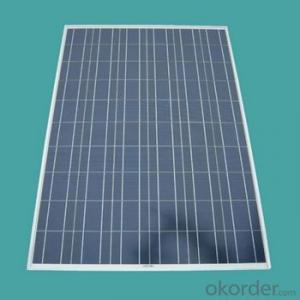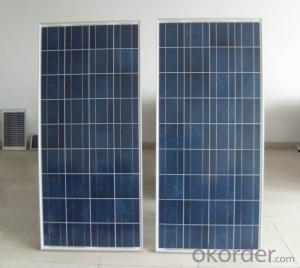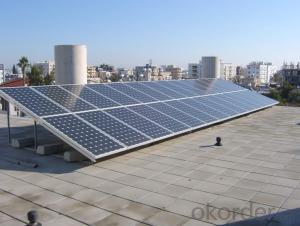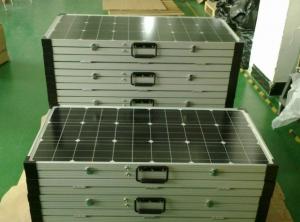Best Solar Panels Company 250w Polycrystalline Silicon Solar Panels
- Loading Port:
- Guangzhou
- Payment Terms:
- TT OR LC
- Min Order Qty:
- 200000 watt
- Supply Capability:
- 20000000 watt/month
OKorder Service Pledge
OKorder Financial Service
You Might Also Like
INTRODUCTION
This installation Manual contains essential information for the electrical and mechanical installation that your must know before installing CUSTOMER PV modules. This also contains safety information you need to be familiar with .All the information described in this manual are the intellectual property of CNBM and based on the technologies and experiences that have been acquired and accumulated in the long history of CUSTOMER. This document does not constitute a warranty, expressed or implied.
CUSTOMER does not assume responsibility and expressly disclaims liability for loss, damage, or expense arising out of in anyway connected with installation, operation, use or maintenance of the PV modules. No responsibility is assumed by CUSTOMER for any infringement of patents or other rights of third parties that may result from use of PV module.
CUSTOMER reserves the right to make changes to the product, specifications or installation manual without prior notice.
GENERAL INFORMATION
The installation of PV modules requires a great degree of skill and should only be performed by a qualified licensed professional, including licensed contractors and licensed electricians. Please be aware that there is a serious risk of various types of injury occurring during the installation including the risk of electric shock. All CUSTOMER modules are equipped with a permanently attached junction terminal box that will accept variety of wiring applications or with a special cable assembly for ease of installation, and they do not require assembly.
COMPONENTS
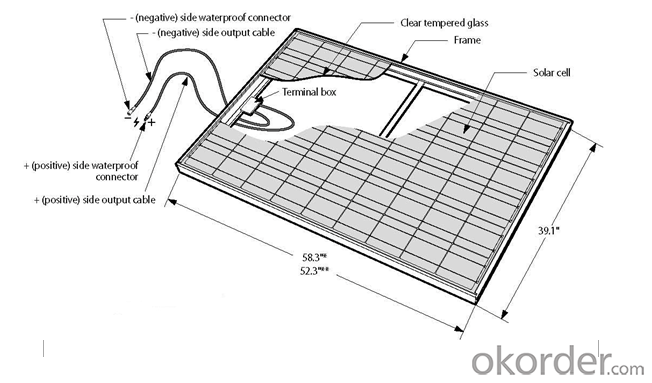
SITE SELECTION
In most applications, the PV modules should be installed in location where there is no shading throughout the year. In the Northern Hemisphere, The PV modules should typically face south, and in the Southern Hemisphere, the PV modules should typically face north. Please make sure that there are no obstruction in the surroundings of the site of installation. Take proper steps in order to maintain reliability and safety, in case the PV modules are used in areas such as: Heavy snow areas/Extremely code areas/ Strong wind areas/Installation over, or near, water/ Areas where installations are prone to salt water damage (*)/Small islands or desert areas.(*)
If you are planning to use the PV modules where the salt water damage may be possible consult with CNBM local agent first to determine an appropriate installation method, or to determine whether the installation is possible?
Data sheet
Maximum Power | 250W |
Efficiency | 0.154 |
Backsheet | White |
Frame Colar | Silver |
Manufacture Site | China |
Frame | Anodized Aluminum Alloy |
Weight | 19 kg |
TILT ANGLE
The title angle of the PV module is the measured between the PV module and a horizontal ground surface. The PV module generates the maximum output power when it faces the sun directly.
For the standalone systems with a battery where the PV modules are attached to a permanent structure , the tile angle of the PV modules should be determined to optimize the performance when the sunlight is the scarcest. In general, if the electric power generation is adequate when the sunlight is the scarcest, then the angle chosen should be adequate during the rest of the year. For grid-connected installations where the PV modules are attached to a permanent structure, it is recommended to tilt the PV module at the angle equal to the latitude of the installation site so that the power generation from the PV module will be optimum throughout the year.
- Q: solar energy
- If you want to know how solar panels are made look here www.google.ca/search?hl=enq=how+... If you want to know how they are manufactured.
- Q: What about sources for straight forward solar powered products? Excluding toys, garden frogs and outdoorpath lights I have found few useful items for the home. What I have found are solar panels for under $00 each, inverters, rechargeable indoor lights and a few camping/RV products that are interesting. It seems to me that these could help me start to wean the family off the power company. I can't afford to go cold turkey and cover my roof with solar panels and I don't think the HOA would allow me to even if I could. Is anyone using solar on a small scale?
- Homemade okorder
- Q: How much does it cost to replace a solar panel?
- The cost of replacing a solar panel can vary depending on the size, quality, and type of panel, as well as any additional installation costs. On average, a basic solar panel replacement can range from $500 to $1,500 per panel, but it's recommended to consult a solar installer or supplier for a more accurate estimate tailored to your specific needs.
- Q: Hi! I bought a Coleman 2 vdc cooler that pulls 9 amps. What size solar panel and amp-hour battery do I need? I only open it 3 times a day. It will hold about 3 gals of milk.
- If it pulls 9 amps continuously, that's 08 watts/hour or about 2.5 kwh/day. If it only pulls half that (does it cycle?) it's about .2 kwh/day. You only want to drain a lead-acid battery 50% or so, so you'll want a 5 or 2.5 kwh battery pack. A typical setup for the 5 kwh would be two L-6 batteries in series, and for the 2.5 kwh you could use 2 T-05 batteries in series. This does not account for days of cloud. If you regularly have cloudy days, size the battery pack for two or three days of use with no input (2-3 x the sizes given above). To charge them, you typically want panels that will charge your battery at least 5% of its capacity per hour (C/20). For 2 volt nominal panels that's 0 amps for the T-05 or 20 amps for the L-6 batteries. It's good to have more than that for battery life (it cuts down on what's called stratification), so you'll want probably 50-200 watts of panels for the T-05 and 300-400 for the L-6. You'll also need a charge controller. Peltier coolers are very inefficient. You'll save money by using a regular mini-fridge and an inverter. Most mini-fridges only draw 50 watts or so, so you're talking 600 watt-hours for a 50% duty cycle. This means two T-05 batteries will give you two days of use and you'll only need 20-50 watts of panel. DK
- Q: Do solar panels require a backup generator?
- No, solar panels do not require a backup generator. They generate electricity directly from sunlight and can store excess energy in batteries for use when the sun is not shining.
- Q: my solar panel is 5v 50 mA, and im making iphone USB charger so i need to connect + with 00 ohm resister and to data - and + so what resister will be okay..?
- Just connect the 5 volts out of the panel directly to the iphone via an USB connector. BUT, is the panel output always 5 volts, ±0.25 volts? Because that is the USB specification, and anything outside of those values could damage your iphone. And solar panels are known for their wide swings in voltage. Bottom line, resistor not needed, and you need to be positive you supply the correct voltage to the iphone. Best way to do that is to start with a solar panel that puts out at least 7 volts and use a LM7805 regulator. The only resistors needed are those to tie the data lines into a certain combination of resistance and voltage so that the iphone is fooled into thinking that a proper USB is connected. That would NOT involve a 00 ohm resistor. Search online for the proper values and connections. edit: are you repeating your same inane question with a different account? That is totally against the rules and could get you suspended.
- Q: I am working on a project and I have to build a house with solar panels. My teacher asked me how would I get solar energy if it is rainy or cloudy? I looked it up but didn't understand. Please help me!!
- Solar panels convert light energy into electrical energy with the photovoltaic process. They work best when perpendicular to the incoming sunlight and with no clouds in bright sunlight. They will work at reduced efficiency if there are clouds or rain, but as long as its not dark, they will still produce some electricity. That is one of the real problems with solar energy, as we expect to have electricity available on demand, regardless of day/night cycles and atmospheric conditions. Storing electricity is very inefficient, so we need hydro, nuclear,or fossil fuel energy to provide firm on demand energy as a base load.
- Q: How do solar panels affect the resale value of a home?
- Solar panels can have a positive impact on the resale value of a home. Studies have shown that properties with solar panels tend to sell faster and at a higher price compared to homes without them. Potential buyers view solar panels as a valuable and eco-friendly feature, leading to increased buyer interest and willingness to pay a premium for a home equipped with solar power.
- Q: Im fourteen and looking for a career I already know solar panels capture the sun and turn it into energy but i would like to know more.
- A solar panel is a collection of solar cells (photovoltaic cells) connected together and put in an enclosure. The solar cells work by taking advantage of the photovoltaic effect. The effect is that in a semiconductor P-N junction, when photons of suitable energy strike the junction, an electron and electron-hole pair are generated. This creates a voltage difference between the two sides. When this voltage is applied to a circuit, the electrons are able to flow through, creating usable energy.
- Q: Do solar panels require a specific type of mounting system for installation?
- Yes, solar panels typically require a specific type of mounting system for installation. The mounting system is designed to securely hold the solar panels in place and ensure optimal positioning for maximum sunlight exposure. There are various types of mounting systems available, including roof mounts, ground mounts, and pole mounts, each suited for different installation scenarios.
Send your message to us
Best Solar Panels Company 250w Polycrystalline Silicon Solar Panels
- Loading Port:
- Guangzhou
- Payment Terms:
- TT OR LC
- Min Order Qty:
- 200000 watt
- Supply Capability:
- 20000000 watt/month
OKorder Service Pledge
OKorder Financial Service
Similar products
Hot products
Hot Searches
Related keywords
